Van Gogh at even his most fantastic moment, even when he cut off his ear, was convinced that an ear is an ear as every one could see it, the need for that ear might be something else but the ear was the same ear everybody could see.
But with Picasso, Spaniard that he is, it was entirely different. Well, Don Quixote was a Spaniard, he did not imagine things, he saw things and it was not a dream, it was not lunacy, he really saw them.
Well Picasso is a Spaniard.
I was very much struck at this period, when cubism was a little more developed, with the way Picasso could put objects together and make a photograph of them, I have kept one of them, and by the force of his vision it was not necessary that he paint the picture. To have brought the objects together already changed them to other things, not to another picture but to something else, to things as Picasso saw them.
But as I say, Spaniards and Americans are not like Europeans, they are not like Orientals, they have something in common, that is they do not need religion or mysticism not to believe in reality as all the world knows it, not even when they see it. In fact reality for them is not real and that is why there are skyscrapers and American literature and Spanish painting and literature.
So Picasso commenced and little by little there came the picture Les Desmoiselles d’Avignon and when there was that it was too awful. I remember, Tschoukine who had so much admired the painting of Picasso was at my house and he said almost in tears, what a loss for French art.
In the beginning when Picasso wished to express heads and bodies not like every one could see them, which was the problem of other painters, but as he saw them, as one can see when one has not the habit of knowing what one is looking at, inevitably when he commenced he had the tendency to paint them as a mass as sculptors do or in profile as children do.
African art commenced in 1907 to play a part in the definition of what Picasso was creating, but in the creations of Picasso really African art like the other influences which at one time or another diverted Picasso from the way of painting which was his, African art and his French cubist comrades were rather things that consoled Picasso’s vision than aided it, African art, French cubism and later Italian influence and Russian were like Sancho Panza was with Don Quixote, they wished to lead Picasso away from his real vision which was his real Spanish vision. The things that Picasso could see were the things which had their own reality, reality not of things seen but of things that exist. It is difficult to exist alone and not being able to remain alone with things, Picasso first took as a crutch African art and later other things.
Let us go back to the beginning of cubism.
He commenced the long struggle not to express what he could see but not to express the things he did not see, that is to say the things everybody is certain of seeing but which they do not really see. As I have already said, in looking at a friend one only sees one feature of her face or another, in fact Picasso was not at all simple and he analysed his vision, he did not wish to paint the things that he himself did not see, the other painters satisfied themselves with the appearance, and always the appearance, which was not at all what they could see but what they knew was there.
There is a difference.
Now the dates of this beginning.
Picasso was born in Malaga, October 25th, 1881. His parents settled definitely in Barcelona in 1895 and the young Picasso came for the first time in 1900 to Paris where he stayed six months.
The first influence in Paris was Toulouse Lautrec, at this time and later, until his return to Paris in 1901, the influence of this first contact with Paris was quite strong, he returned there in the spring of 1901, but not to stay for long and he returned to Barcelona once more. The direct contact with Paris the second time destroyed the influences of Paris, he returned again to Barcelona and remained there until 1904 when he really became an inhabitant of Paris.
During this period, 1901 to 1904, he painted the blue pictures, the hardness and the reality which are not the reality seen, which is Spanish, made him paint these pictures which are the basis of all that he did afterwards.
In 1904 he came back to France, he forgot all the Spanish sadness and Spanish reality, he let himself go, living in the gaiety of things seen, the gaiety of French sentimentality. He lived in the poetry of his friends, Apollinaire, Max Jacob and Salmon, as Juan Gris always used to say, France seduces me and she still seduces me, I think this is so, France for Spaniards is rather a seduction than an influence.
So the harlequin or rose period was a period of enormous production, the gaiety of France induced an unheard of fecondity. It is extraordinary the number and size of the canvases he painted during this short period, 1904–1906.
Later one day when Picasso and I were discussing the dates of his pictures and I was saying to him that all that could not have been painted during one year Picasso answered, you forget we were young and we did a great deal in a year.
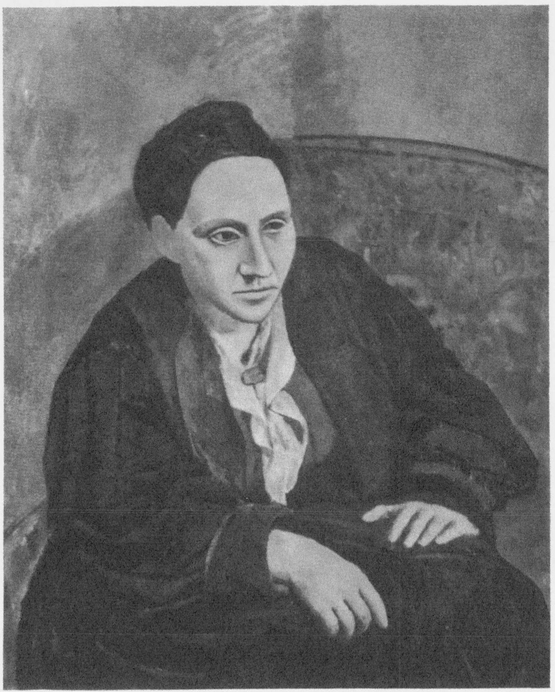
22 PORTRAIT OF MISS GERTRUDE STEIN (1906)
Really it is difficult to believe that the harlequin period only lasted from 1904 to 1906, but it is true, there is no denying it, his production upon his first definite contact with France was enormous. This was the rose period.
The rose period ended with my portrait, the quality of drawing had changed and his pictures had already commenced to be less light, less joyous. After all Spain is Spain and it is not France and the twentieth century in France needed a Spaniard to express its life and Picasso was destined for this. Really and truly.
When I say that the rose period is light and happy everything is relative, the subjects which were happy ones were a little sad, the families of the harlequins were wretched families but from Picasso’s point of view it was a light happy joyous period and a period when he contented himself with seeing things as anybody did. And then in 1906 this period was over.
In 1906 Picasso worked on my portrait during the whole winter, he commenced to paint figures in colors that were almost monotone, still a little rose but mostly an earth color, the lines of the bodies harder, with a great deal of force there was the beginning of his own vision. It was like the blue period but much more felt and less colored and less sentimental. His art commenced to be much purer.
So he renewed his vision which was of things seen as he saw them.
One must never forget that the reality of the twentieth century is not the reality of the nineteenth century, not at all and Picasso was the only one in painting who felt it, the only one. More and more the struggle to express it intensified. Matisse and all the others saw the twentieth century with their eyes but they saw the reality of the nineteenth century, Picasso was the only one in painting who saw the twentieth century with his eyes and saw its reality and consequently his struggle was terrifying, terrifying for himself and for the others, because he had nothing to help him, the past did not help him, nor the present, he had to do it all alone and, as in spite of much strength he is often very weak, he consoled himself and allowed himself to be almost seduced by other things which led him more or less astray.
Upon his return from a short trip to Spain, he had spent the summer at Gosol, he returned and became acquainted with Matisse through whom he came to know African sculpture. After all one must never forget that African sculpture is not naive, not at all, it is an art that is very very conventional, based upon tradition and its tradition is a tradition derived from Arab culture. The Arabs created both civilisation and culture for the negroes and therefore African art which was naive and exotic for Matisse was for Picasso, a Spaniard, a thing that was natural, direct and civilised.
So then it was natural that this reinforced his vision and helped him to realise it and the result was the studies which brought him to create the picture of Les Desmoiselles d’Avignon.
Again and again he did not recommence but he continued after an interruption. This is his life.
It was about this period that his contact with Derain and Braque commenced and little by little pure cubism came to exist.
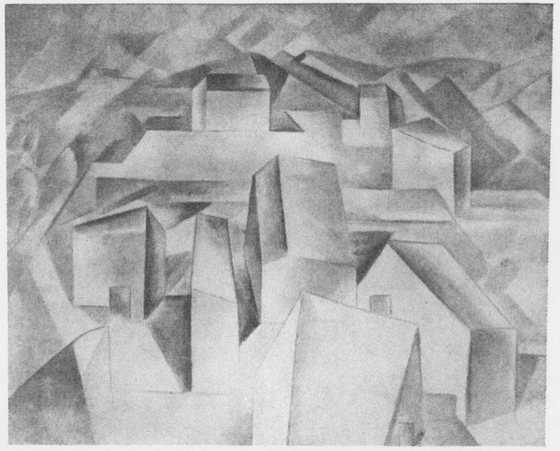
23 VILLAGE IN TARRAGONA (1909)
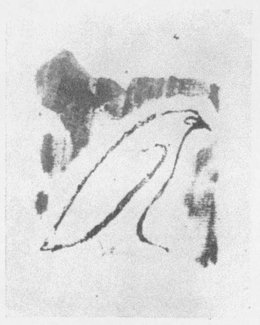
24 WOOD ENGRAVING (1905)
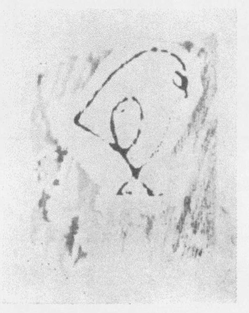
25 WOOD ENGRAVING (1905)
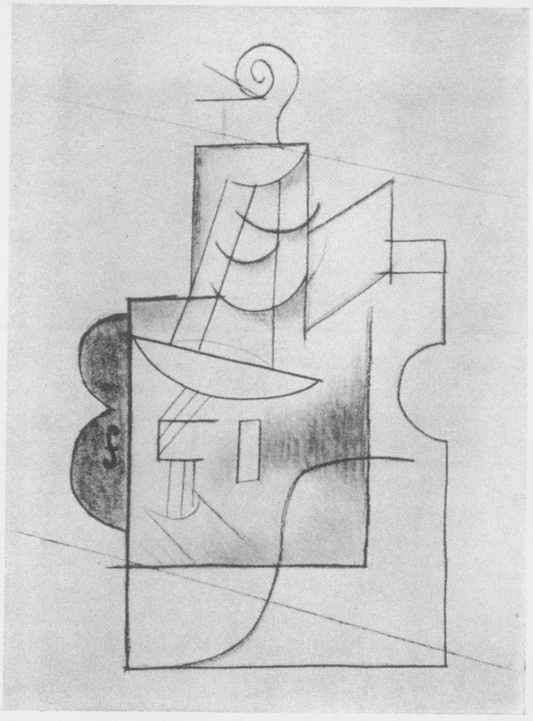
26 THE VIOLIN : Charcoal Drawinh (1912)
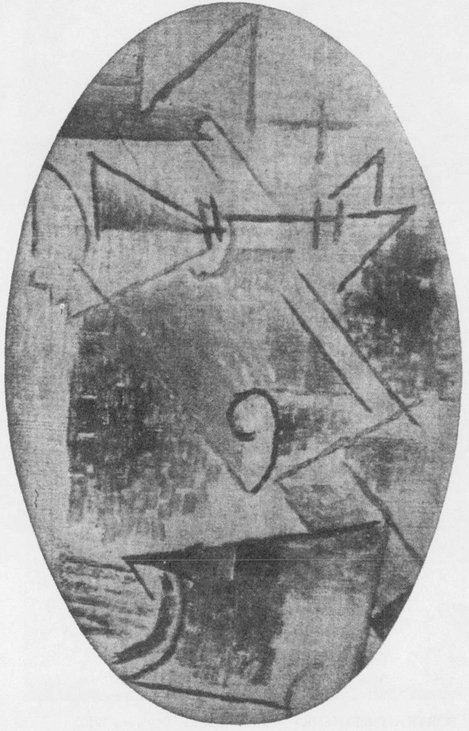
27 STILL-WITH GLASS (Spring, 1912)
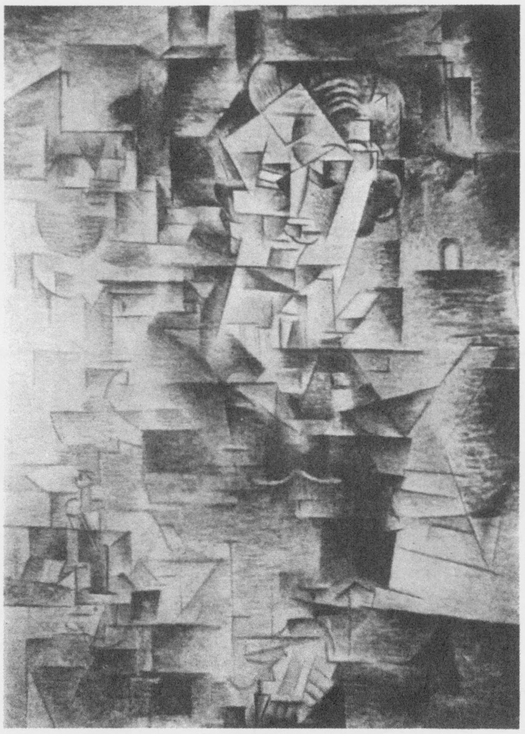
28 PORTRAIT OF HENRY KAHNWEILER (Autumn, 1910)
First there was the effort, still more difficult than with still lifes and landscapes, to create human beings in cubes, exhausted, Picasso emptied himself during 1907 and calmed himself by doing sculpture. Sculpture always has the bother that one can go all around it and the material of which it is made gives an impression of form before the sculptor has worked on it.
I myself prefer painting.
Picasso having made a prodigious effort to create painting by his understanding of African sculpture was seduced a short time after 1908 by his interest in the sculptural form rather than by the vision in African sculpture but even so in the end it was an intermediate step toward cubism.
Cubism is a part of the daily life in Spain, it is in Spanish architecture. The architecture of other countries always follows the line of the landscape, it is true of Italian architecture and of French architecture, but Spanish architecture always cuts the lines of the landscape and it is that that is the basis of cubism, the work of man is not in harmony with the landscape, it opposes it and it is just that that is the basis of cubism and that is what Spanish cubism is. And that was the reason for putting real objects in the pictures, the real newspaper, the real pipe. Little by little, after these cubist painters had used real objects, they wanted to see if by the force of the intensity with which they painted some of these objects, a pipe, a newspaper, in a picture, they could not replace the real by the painted objects which would by their realism require the rest of the picture to oppose itself to them.
Nature and man are opposed in Spain, they agree in France and this is the difference between French cubism and Spanish cubism and it is a fundamental difference.
So then Spanish cubism is a necessity, of course it is.
So now it is 1908 and once more Picasso is in Spain and he returned with the landscapes of 1909 which were the beginning of classic and classified cubism.
These three landscapes express exactly what I wish to make clear, that is to say the opposition between nature and man in Spain. The round is opposed to the cube, a small number of houses gives the impression of a great quantity of houses in order to dominate the landscape, the landscape and the houses do not agree, the round is opposed to the cube, the movement of the earth is against the movement of the houses, in fact the houses have no movement because the earth has its movement, of course the houses should have none.
I have here before me a picture of a young French painter, he too with few houses creates his village, but here the houses move with the landscape, with the river, here they all agree together, it is not at all Spanish.
Spaniards know that there is no agreement, neither the landscape with the houses, neither the round with the cube, neither the great number with the small number, it was natural that a Spaniard should express this in the painting of the twentieth century, the century where nothing is in agreement, neither the round with the cube, neither the landscape with the houses, neither the large quantity with the small quantity. America and Spain have this thing in common, that is why Spain discovered America and America Spain, in fact it is for this reason that both of them have found their moment in the twentieth century.
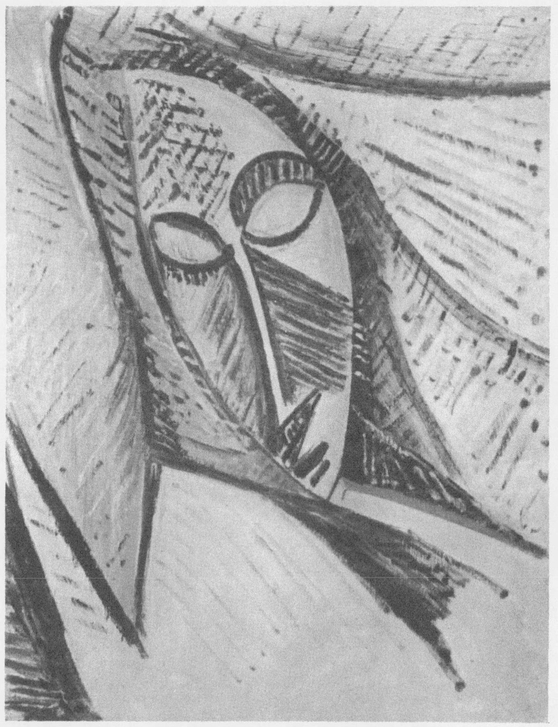
29 HEAD OF A WOMAN (1913)
So Picasso returned from Spain after a summer spent in Barcelona and in Orta de Ebro and he was once again in the rue Ravignan, but it was the beginning of the end of the rue Ravignan, actually he did not leave the rue Ravignan until 1910, but the return in 1909 was really the end of the rue Ravignan which had given him all that it would give him, that was over and now began the happy era of cubism. There was still a great deal of effort, the continual effort of Picasso to express the human form, that is to say the face, the head, the human body in the composition which he had then reached, the features seen separately existed separately and at the same time it all was a picture, the struggle to express that at this time was happy rather than sad.
1 comment